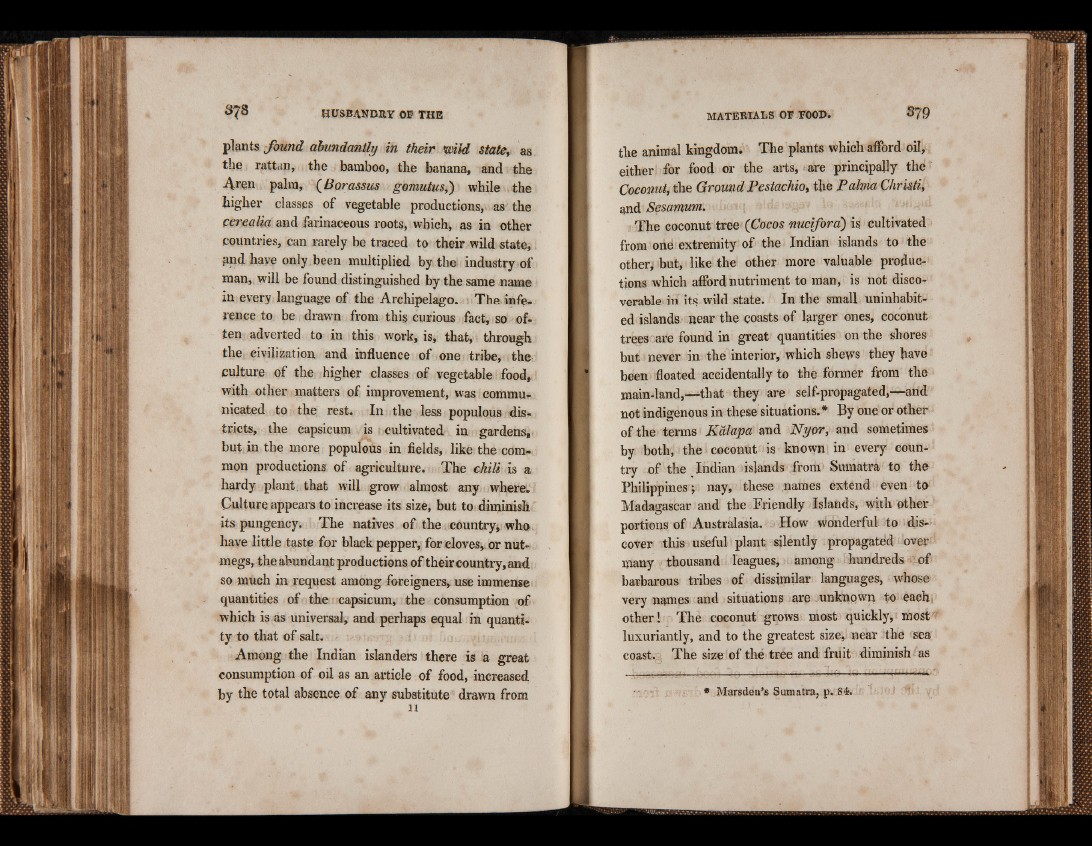
plants j found abundantly in their wild state, as
the rattan, the bamboo, the banana, and the
Aren palm, ( Borassus gomutus,) while the
higher classes of vegetable productions, as the
cerealia and farinaceous roots, which, as in other
countries, can rarely be traced to their wild state,
and have only been multiplied by the industry of
man,, will be found distinguished by the same name
in every language of the Archipelago. The inference
to be drawn from this curious fact, so often
adverted to in this work, is, that, through
the civilization and influence of one tribe, the
culture of the higher classes of vegetable food,
with other matters of improvement, was communicated
to the rest. In the less populous districts,
the capsicum is cultivated in gardens,
but in the more populous in fields, like the common
productions of agriculture. The chili is a
hardy plant, that will grow almost any where.
Culture appears to increase its size, but to diminish
its pungency. The natives of the country* who
have little taste for black pepper, for cloves, or nutmegs,
the abundant productions of their country, and
so much in request among foreigners, use immense
quantities of the - capsicum, the consumption of
which is as universal, and perhaps equal in quantity
to that of salt.
Among the Indian islanders there is a great
consumption of oil as an article of food, increased
by the total absence of any substitute drawn from
the animal kingdom; The plants which afford oil,
either for food or the arts, are principally the
Cocomit, the Ground Pestachio, the Palma Christi,
and Sesamum.
The coconut tree (Cocos nucifora) is cultivated
from one extremity of the Indian islands to the
other, but, like the other more valuable productions
which afford nutriment to man, is not disco-r
verable in its wild state. In the small uninhabited
islands near the coasts of larger ones, coconut
trees are found in great quantities on the shores
but never in the interior, which shews they have
been floated accidentally to the former from the
main-land,—-that they are self-propagated,—and
not indigenous in these situations.* By one or other
of the terms Kalapa and Nyor, and sometimes
by both, the coconut is known in every country
of the Indian islands from1 Sumatra to the
Philippines ; nay, these names extend even to
Madagascar and the Friendly Islands, with other
portions of Australasia. How wonderful to discover
this useful plant silently propagated over
many thousand leagues, among hundreds« of
barbarous tribes of dissimilar languages, whose
very names and situations are unknown to each
other ! The coconut grows most quickly, most
luxuriantly, and to the greatest size, near the sea
coast. The size of the tree and fruit diminish as
* Marsdeu’s Sumatra, p. 84.